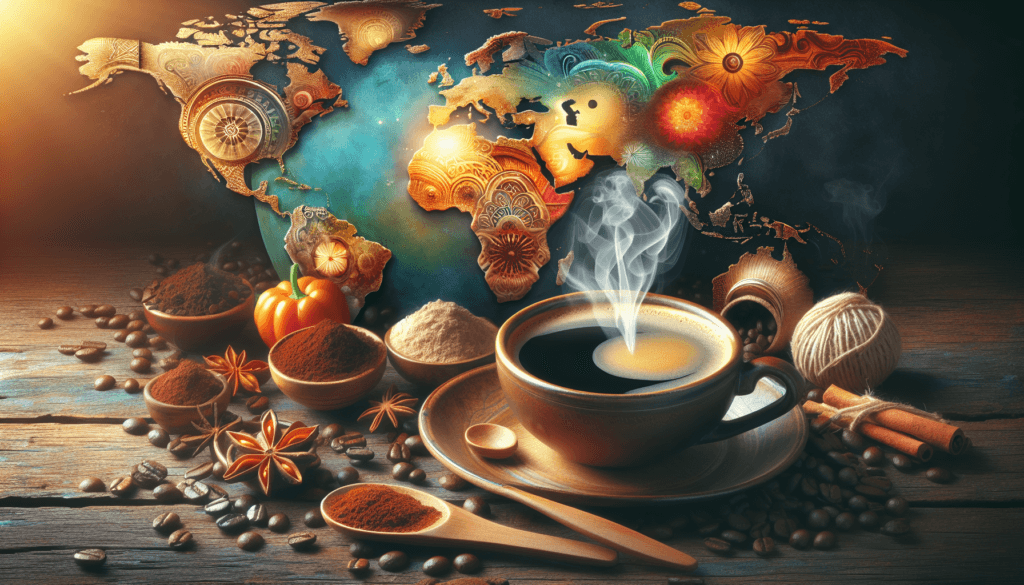When it comes to coffee, there are countless varieties and flavors to choose from, each with its own unique characteristics. But have you ever wondered which type of coffee is the most popular and widely consumed? In this article, we will explore the answer to this question and uncover the drink that reigns supreme in the world of coffee lovers. Whether you’re a dedicated espresso enthusiast or a fan of creamy cappuccinos, stay tuned to discover the favorite coffee choice of millions around the globe.

Types of coffee
Arabica
Arabica coffee is one of the most popular and widely consumed types of coffee worldwide. Known for its rich flavor and lower levels of acidity, Arabica beans are grown in various regions around the world. They are often considered more premium, compared to other coffee varieties. Arabica coffee is commonly used in specialty coffee shops and is the preferred choice for those who enjoy a smooth and well-rounded cup of coffee.
Robusta
Robusta coffee, as the name suggests, is known for its robust and strong flavor profile. This type of coffee is higher in caffeine and has a higher acidity level compared to Arabica. Robusta beans are often used in blends to add depth and intensity to the flavor. This variety is popular for those who prefer a more bold and strong taste in their coffee.
Instant coffee
Instant coffee is a convenient and quick alternative for those who want a cup of coffee on the go. It is made by freeze-drying or spray-drying brewed coffee to remove the water content, leaving behind a soluble powder. Instant coffee offers a quick and easy way to make coffee, requiring only hot water to dissolve the powder. While it may not have the same depth of flavor as freshly brewed coffee, instant coffee remains a popular choice for its convenience and accessibility.
Espresso
Espresso is a concentrated form of coffee, characterized by its strong flavor and thicker consistency. It is made by forcing hot water through finely ground coffee beans under high pressure. Espresso is the foundation for many coffee-based beverages, such as cappuccinos and lattes. It is typically served in small, demitasse-sized cups and enjoyed for its intense and bold taste.
Cappuccino
Cappuccino is a popular Italian coffee beverage that combines espresso, steamed milk, and a layer of frothed milk on top. It is known for its smooth and creamy texture, with the espresso providing a robust and rich flavor. Cappuccinos are often enjoyed as a breakfast or mid-morning beverage and can be customized with various flavors, such as chocolate or caramel.
Latte
Similar to a cappuccino, a latte consists of espresso and steamed milk. However, a latte has a higher milk-to-espresso ratio, resulting in a smoother and milder taste. It is often topped with a small amount of frothed milk and can be flavored with syrups or sprinkled with cocoa powder. Lattes are a popular choice for those who enjoy the creaminess of milk in their coffee.
Americano
An Americano is a simple and light-bodied coffee beverage made by diluting espresso with hot water. It has a similar strength to drip coffee but retains the distinct flavor profile of espresso. Americanos are often enjoyed black or with a splash of milk, depending on personal preference. This type of coffee is a popular choice for those who prefer a milder taste but still want the rich flavor of espresso.
Mocha
Mocha, also known as a mochaccino, is a delicious blend of espresso, chocolate, and steamed milk. It offers a perfect balance between the bitterness of coffee and the sweetness of chocolate. Mochas are often topped with whipped cream and chocolate drizzle, making it a popular choice for those with a sweet tooth. This indulgent treat is a favorite among coffee lovers who enjoy a rich and decadent beverage.
Macchiato
Macchiato, meaning “stained” in Italian, is a shot of espresso with a small amount of milk or foam added on top. It is a strong and concentrated coffee beverage that provides a bolder flavor compared to other types of coffee. Macchiatos are often enjoyed as a quick and flavorsome pick-me-up, perfect for those who appreciate the pure taste of espresso with a touch of milk.
Black coffee
Black coffee refers to coffee that is served as is, without any additions such as milk or sugar. It is a simple and straightforward way to enjoy the natural flavors and aromas of coffee. Black coffee can be made using various brewing methods, such as drip coffee or French press. It is a popular choice for those who prefer the bold and pure taste of coffee without any embellishments.
Global coffee consumption
Top coffee-consuming countries
Coffee consumption varies widely across countries, with some nations exhibiting a strong coffee culture and high consumption rates. The top coffee-consuming countries include Brazil, the United States, Germany, Japan, and France. These countries have a long-standing coffee tradition and a large population of coffee enthusiasts.
Regional preferences
Each region of the world has its own unique coffee preferences. In North America, for example, drip coffee and flavored coffee drinks are popular choices. Latin America is known for its strong espresso culture, while European countries, such as Italy and Spain, have a tradition of enjoying espresso-based beverages. In Asia, countries like Japan and South Korea have seen a rise in specialty coffee consumption. Africa, the birthplace of coffee, has a diverse range of coffee preferences, with countries like Ethiopia known for their traditional coffee ceremonies. Australia has a vibrant coffee scene, with a preference for high-quality espresso-based beverages.
Impact of cultural traditions
Cultural traditions play a significant role in shaping coffee consumption habits. In countries like Italy, coffee is often seen as a social and cultural activity, with espresso bars serving as gathering places for friends and neighbors. In contrast, countries like the United States have a more individualistic approach to coffee consumption, with coffee being enjoyed on-the-go or as a personal indulgence. Cultural traditions also influence the types of coffee beverages consumed, such as the traditional Turkish coffee or Vietnamese iced coffee.
Market trends
The coffee industry is continually evolving, with market trends influencing coffee consumption patterns. Currently, there is a growing demand for specialty coffee, which focuses on high-quality beans and artisanal brewing techniques. Consumers are becoming more interested in the origin, processing methods, and flavor profiles of their coffee. Sustainability and ethical concerns are also increasingly important factors, with consumers looking for coffee that is ethically sourced and produced in an environmentally friendly manner.
Popular coffee chains
Coffee chains have become a significant part of the global coffee culture. Brands like Starbucks, Costa Coffee, and Dunkin’ Donuts have established a strong presence worldwide, catering to various consumer preferences. These chains offer a wide range of coffee beverages and have successfully created their own unique coffee experiences. They also contribute to the popularity of coffee consumption by providing convenient and familiar options for consumers.

Regional preferences
North America
In North America, coffee consumption is prevalent, with drip coffee being the most popular choice for many. This region has a strong coffee culture, with coffeehouses and cafes playing a central role in the social fabric. Besides traditional drip coffee, Americans also enjoy flavored coffee drinks, such as caramel macchiatos and pumpkin spice lattes. Additionally, the rise of specialty coffee shops has introduced North Americans to a wide variety of brewing methods, including pour-over and cold brew.
Latin America
Latin America is known for its deep-rooted coffee culture and production. Countries like Brazil, Colombia, and Peru are among the top coffee producers globally, with a significant portion of their coffee being consumed domestically. Espresso is a staple in Latin American countries, with espresso bars and cafeterias being popular gathering places for locals. Alongside the espresso, Latin Americans also enjoy coffee-based cocktails, such as the renowned Brazilian caipirinha.
Europe
Europe has a rich coffee history, with countries like Italy, France, and Spain known for their coffee traditions. Italy, for example, is famous for its espresso culture, where locals enjoy a quick shot of strong coffee at espresso bars. Italy is also the birthplace of iconic coffee beverages like cappuccino and latte. In France, coffee is often enjoyed alongside a croissant or a pastry, with the French savoring a slower and more leisurely coffee experience.
Asia
Coffee consumption in Asia has seen significant growth in recent years, with countries like Japan, South Korea, and China embracing specialty coffee. In Japan, coffeehouses known as “kissaten” offer a unique coffee experience, serving carefully brewed coffee with attention to detail. South Korea is known for its “dabang” culture, where coffee shops are decorated with a vintage ambiance, offering a cozy and nostalgic atmosphere for coffee lovers. In China, the rising middle class has shown an increased interest in Western coffee culture, with specialty coffee shops becoming more prevalent.
Africa
As the birthplace of coffee, Africa has a rich coffee heritage and diverse coffee preferences. In Ethiopia, coffee holds significant cultural importance, with traditional coffee ceremonies being a cherished social activity. Ethiopian coffee is known for its distinct fruity and floral flavors, making it highly sought after in specialty coffee markets. In other African countries like Kenya and Rwanda, coffee is also consumed in various forms, often with a preference for lighter roast profiles and vibrant acidity.
Australia
Australia has developed a vibrant coffee culture, with a strong emphasis on high-quality espresso-based beverages. Australians are known for their love of coffee, with many enjoying a morning latte or flat white as part of their daily routine. Australian coffee shops often focus on sourcing top-tier beans and perfecting their latte art. The country’s baristas have gained international recognition for their dedication to crafting exceptional coffee experiences.
Factors influencing coffee consumption
Availability
The availability of coffee plays a significant role in determining consumption rates. Countries with favorable climate conditions for coffee cultivation, such as Brazil and Colombia, often have a higher coffee consumption due to the abundance of locally grown coffee. Additionally, the accessibility of coffee shops and cafes also contributes to higher consumption rates, as people can easily satisfy their coffee cravings in a convenient and timely manner.
Price
Price is a major factor that influences coffee consumption. Higher coffee prices can lead to reduced consumption, as consumers may opt for more affordable alternatives or reduce their overall coffee intake. Conversely, lower coffee prices can stimulate higher consumption rates, as it becomes more accessible and affordable for a wider range of consumers. Price fluctuations in the coffee market can impact consumption patterns at both individual and national levels.
Taste preferences
Individual taste preferences greatly influence coffee consumption. Some individuals prefer the bold and strong flavors of robusta coffee, while others prefer the smoother and more nuanced flavors of arabica coffee. Additionally, personal preferences for sweetness, acidity, and bitterness also shape coffee choices. The introduction of flavored coffee, such as vanilla or caramel, has further expanded the options available to consumers, catering to a wide range of taste preferences.
Caffeine content
The caffeine content of coffee is a significant factor for many consumers. Coffee is a natural source of caffeine, a stimulant that provides an energy boost and helps reduce fatigue. Some individuals prefer higher caffeine content, seeking a more energizing and awakening effect. Others may opt for decaffeinated coffee due to personal preferences or health reasons. The caffeine content in coffee can impact consumption habits, particularly in relation to the time of day and individual tolerance levels.
Health benefits
Coffee is known to have various health benefits, which can influence consumption habits. Research has shown that moderate coffee consumption may have positive effects on heart health, liver function, and even cognitive function. The perceived health benefits of coffee can motivate individuals to consume it regularly as part of a balanced lifestyle. However, it is important to note that excessive consumption or the addition of unhealthy ingredients, such as sugar or cream, can offset these potential benefits.
Social trends
Social trends and cultural influences can heavily impact coffee consumption. The rise of specialty coffee and the desire for unique coffee experiences have transformed the way people approach and enjoy coffee. Social media platforms have played a significant role in showcasing coffee culture, leading to trends such as latte art, coffee tastings, and coffee tourism. Additionally, the influence of celebrity endorsements and popular culture can also shape consumption patterns, as individuals are drawn to the lifestyles and preferences of their favorite influencers.
Marketing and branding
Effective marketing and branding strategies can significantly influence coffee consumption. Coffee companies invest in various marketing techniques to capture consumers’ attention and create brand loyalty. Clever packaging, engaging advertising campaigns, and endorsements by popular figures can all contribute to increased coffee consumption. Coffee brands also focus on promoting sustainability, fair trade, and ethical sourcing practices, appealing to consumers who prioritize these values in their purchasing decisions.

Instant coffee vs. freshly brewed coffee
Advantages of instant coffee
Instant coffee offers several advantages that appeal to a wide range of coffee consumers. It provides convenience, as it can be quickly prepared by simply adding hot water. Instant coffee is also less expensive than freshly brewed coffee, making it a budget-friendly option for those who want a quick caffeine fix without breaking the bank. Additionally, instant coffee has a longer shelf life compared to fresh coffee, making it a practical choice for those who want to stock up on coffee without worrying about spoilage.
Advantages of freshly brewed coffee
Freshly brewed coffee offers a superior taste and aroma compared to instant coffee. The brewing process allows for the extraction of more complex flavors and nuances from the coffee beans, resulting in a more satisfying and enjoyable cup of coffee. Freshly brewed coffee also provides the opportunity for customization, allowing users to adjust factors such as grind size, water temperature, and brewing method to suit their preferences. Coffee purists often prefer freshly brewed coffee for its depth of flavor and the ability to appreciate the unique characteristics of different coffee beans.
Consumer preferences
Consumer preferences for instant coffee versus freshly brewed coffee vary widely based on factors such as convenience, taste preferences, and budget considerations. Instant coffee is popular among busy individuals who value speed and simplicity in their coffee preparation. It also appeals to those who prioritize cost-effectiveness or do not have access to brewing equipment. On the other hand, coffee enthusiasts and those who appreciate the art and science of coffee brewing tend to favor freshly brewed coffee for its quality, taste, and the overall experience it provides.
Coffee consumption trends
Shift towards specialty coffee
Specialty coffee has seen a significant increase in popularity in recent years. Consumers are becoming more educated and discerning about the origin and quality of their coffee beans. Specialty coffee focuses on beans with exceptional flavors and unique characteristics, often sourced from smaller or independent coffee farms. This trend has led to the rise of specialty coffee shops and an increased interest in brewing methods such as pour-over, AeroPress, and cold brew.
Rise of coffee culture
Coffee culture has grown exponentially, with coffee playing a central role in socializing and community building. Coffee shops and cafes have become gathering places for friends, colleagues, and creatives. Artisanal coffee experiences, such as latte art competitions and cupping sessions, have become popular, allowing coffee enthusiasts to immerse themselves in the intricacies of coffee craftsmanship. This cultural shift towards a deeper appreciation for coffee has led to a greater demand for high-quality coffee and unique coffee experiences.
Growing popularity of cold brew
Cold brew coffee has gained significant popularity in recent years, particularly during the warmer months. Cold brew is made by steeping coffee grounds in cold or room temperature water for an extended period, resulting in a smoother, less acidic, and naturally sweeter coffee. This brewing method appeals to individuals who desire a refreshing and less intense coffee experience. Cold brew also offers versatility, as it can be enjoyed on its own, diluted with water or milk, or used as a base for various coffee beverages.
Sustainability and ethical concerns
The coffee industry is increasingly addressing sustainability and ethical concerns. Consumers are becoming more conscious of the environmental impact and labor practices associated with coffee production. There is a growing demand for ethically sourced and produced coffee, with certifications such as Fair Trade and Rainforest Alliance becoming more sought after. Additionally, initiatives to support farmers and promote sustainable farming practices are gaining traction, empowering coffee producers while ensuring the long-term viability of the coffee industry.
Health-conscious choices
Health-conscious consumers are making informed choices when it comes to their coffee consumption. Alternative milk options, such as almond milk and oat milk, have become popular among those seeking dairy-free or plant-based alternatives. Low-calorie and sugar-free syrups offer a way to indulge in flavored coffee without excessive calories or sugar intake. Additionally, the emergence of functional ingredients, such as adaptogens and superfoods, has led to the creation of coffee blends that offer added health benefits, such as improved focus and energy.

Coffee consumption habits by age group
Youth and millennials
The younger generation, including youth and millennials, has embraced coffee culture and its associated experiences. They often view coffee as more than just a beverage but as an opportunity for self-expression and socialization. Younger consumers are more open to trying new coffee trends, such as specialty coffee and unique brewing methods. They also seek out coffee shops and cafes that align with their values and provide an aesthetically pleasing and Instagram-worthy experience.
Working professionals
Coffee plays a significant role in the lives of working professionals. Many rely on coffee to provide a much-needed energy boost and enhance focus and productivity. Working professionals often have a routine of enjoying a morning cup of coffee before starting their day or grabbing a quick coffee during a break. Convenience and accessibility are key factors driving their coffee consumption habits, with options like drive-thru coffee shops and office coffee machines being popular choices.
Seniors
Seniors are also active coffee consumers, with many having developed a lifelong appreciation for the beverage. Coffee serves as a social lubricant for this age group, providing opportunities for connection and conversation. Seniors may have established preferences for certain types of coffee, such as traditional drip coffee or decaffeinated options due to health considerations. Coffeehouses and senior centers often serve as community hubs, allowing seniors to enjoy coffee alongside social activities and interactions.
Impact on coffee industry
Coffee production and supply
Coffee consumption trends have a direct impact on coffee production and supply. High consumption rates in certain countries can lead to increased demand for coffee beans, impacting production levels. Coffee-producing countries must continually adapt to meet global demand and ensure a stable supply. Climate change, natural disasters, and pest infestations pose challenges to coffee production, highlighting the need for sustainable farming practices and investments in agricultural research.
Coffee pricing
Global coffee consumption also influences coffee pricing. Supply and demand dynamics play a significant role in determining the cost of coffee beans. Higher consumption rates can potentially drive up prices, particularly for specialty and high-quality beans. Fluctuations in currency exchange rates, weather conditions, and market speculation can also impact coffee pricing. Coffee producers, traders, and consumers closely monitor pricing trends to navigate market conditions and make informed decisions.
Global trade and export
Coffee consumption has a direct impact on global trade and export. Coffee is one of the most traded commodities globally, with coffee-producing countries relying on export revenues to drive economic growth. Consumption trends in different regions can impact export volumes and destinations. Emerging coffee markets, such as those in Asia and the Middle East, present new opportunities for coffee producers to diversify their export markets and cater to evolving consumer preferences.
Coffeehouse industry
The coffeehouse industry has experienced remarkable growth due to coffee consumption habits. Coffeehouses and cafes provide not only a space for individuals to enjoy their favorite coffee beverages but also serve as meeting spots, workplaces, and community hubs. This industry contributes to local economies through job creation and generates revenue through coffee and food sales. Coffeehouse chains, in particular, have expanded globally, capitalizing on the popularity of coffee consumption and creating a brand experience that resonates with consumers.
Coffee machinery market
Increased coffee consumption has led to a rise in the coffee machinery market. Coffee brewing equipment, such as espresso machines, grinders, and cold brew systems, are in high demand among coffee enthusiasts, specialty shops, and commercial establishments. The coffee machinery market encompasses both professional-grade equipment used by coffee shops and cafes and home brewing equipment. Innovation in coffee machinery continues to drive advancements in brewing technology, making it easier for consumers to produce cafe-style coffee in their own homes.

Famous coffee-growing regions
Brazil
Brazil is the largest coffee-producing country in the world. It is known for its vast coffee plantations, favorable climate conditions, and production of both arabica and robusta beans. Brazilian coffee is often characterized by its mild acidity and nutty flavors. The country’s coffee industry has played a significant role in shaping the global coffee market.
Colombia
Colombia is renowned for its high-quality arabica coffee. Its favorable altitude, rich soils, and dedicated farmers contribute to the production of specialty coffee with vibrant acidity, balanced flavors, and excellent aroma. Colombian coffee is often regarded as some of the best in the world, and the country’s coffee industry is a source of national pride.
Vietnam
Vietnam is the second-largest coffee producer globally, predominantly cultivating robusta coffee beans. The country’s coffee industry has experienced rapid growth and transformed Vietnam into a major player in the global coffee market. Vietnamese coffee is often known for its strong and bold flavors, with Vietnamese coffee culture emphasizing a unique brewing method using a phin filter and sweetened condensed milk.
Ethiopia
Ethiopia is the birthplace of coffee and holds significant cultural importance in the coffee world. Ethiopian coffee is highly sought after for its diverse range of flavors, including bright citrus notes, floral aromas, and fruity undertones. The country has a rich coffee heritage, with traditional coffee ceremonies being a cherished social activity.
Honduras
Honduras has emerged as a prominent coffee-producing country, known for its high-quality arabica beans. Honduran coffee offers a balance of sweetness and acidity, often displaying notes of chocolate, caramel, and tropical fruits. The country’s coffee industry plays a vital role in supporting rural communities and contributing to the country’s economy.
Mexico
Mexico is known for its unique and flavorful arabica coffee. The country’s coffee production spans various regions, each offering distinct flavor profiles. Mexican coffee is often characterized by its subtle acidity, medium body, and notes of cocoa and nuttiness. The coffee industry in Mexico provides employment opportunities for rural communities and has a strong cultural significance.
Peru
Peru is gaining recognition for its specialty coffee production. The country’s diverse microclimates and high-altitude regions contribute to the cultivation of high-quality arabica coffee. Peruvian coffee is known for its bright acidity, complexity, and fruit-forward flavors. The coffee industry in Peru has played a role in promoting sustainable farming practices and empowering local farmers.
Guatemala
Guatemala is renowned for its unique and exceptional coffee, often considered some of the finest in the world. The country’s high-altitude regions, volcanic soils, and ideal climate conditions result in coffee with vibrant acidity and diverse flavor profiles. Guatemalan coffee offers a balance of sweetness, brightness, and complexity, with notes of chocolate, caramel, and tropical fruits.
Conclusion
Coffee consumption is a global phenomenon, driven by a diverse range of factors such as taste preferences, cultural traditions, price, and availability. Different types of coffee cater to various taste preferences, from the robust and strong flavors of robusta coffee to the smooth and well-rounded taste of arabica coffee. Regional preferences and cultural traditions shape coffee consumption habits, with each region and country exhibiting its unique coffee culture. Market trends, sustainability concerns, and health-conscious choices are also influencing coffee consumption patterns.
Instant coffee provides convenience, while freshly brewed coffee offers superior taste and customization options. A shift towards specialty coffee, the rise of coffee culture, and the growing popularity of cold brew highlight evolving consumption trends. Coffee consumption habits also vary by age group, with youth, working professionals, and seniors each having distinct preferences and routines.
The impact of coffee consumption extends to the coffee industry, affecting coffee production, pricing, global trade, the coffeehouse industry, and the market for coffee machinery. Famous coffee-growing regions like Brazil, Colombia, Vietnam, Ethiopia, Honduras, Mexico, Peru, and Guatemala contribute to the global coffee market, each offering unique flavors and characteristics.
As coffee consumption continues to rise worldwide, the coffee industry must navigate changing consumer preferences and address concerns regarding sustainability, ethical sourcing, and health. With innovation, commitment to quality, and a shared love for coffee, the global coffee community will continue to thrive and evolve.


